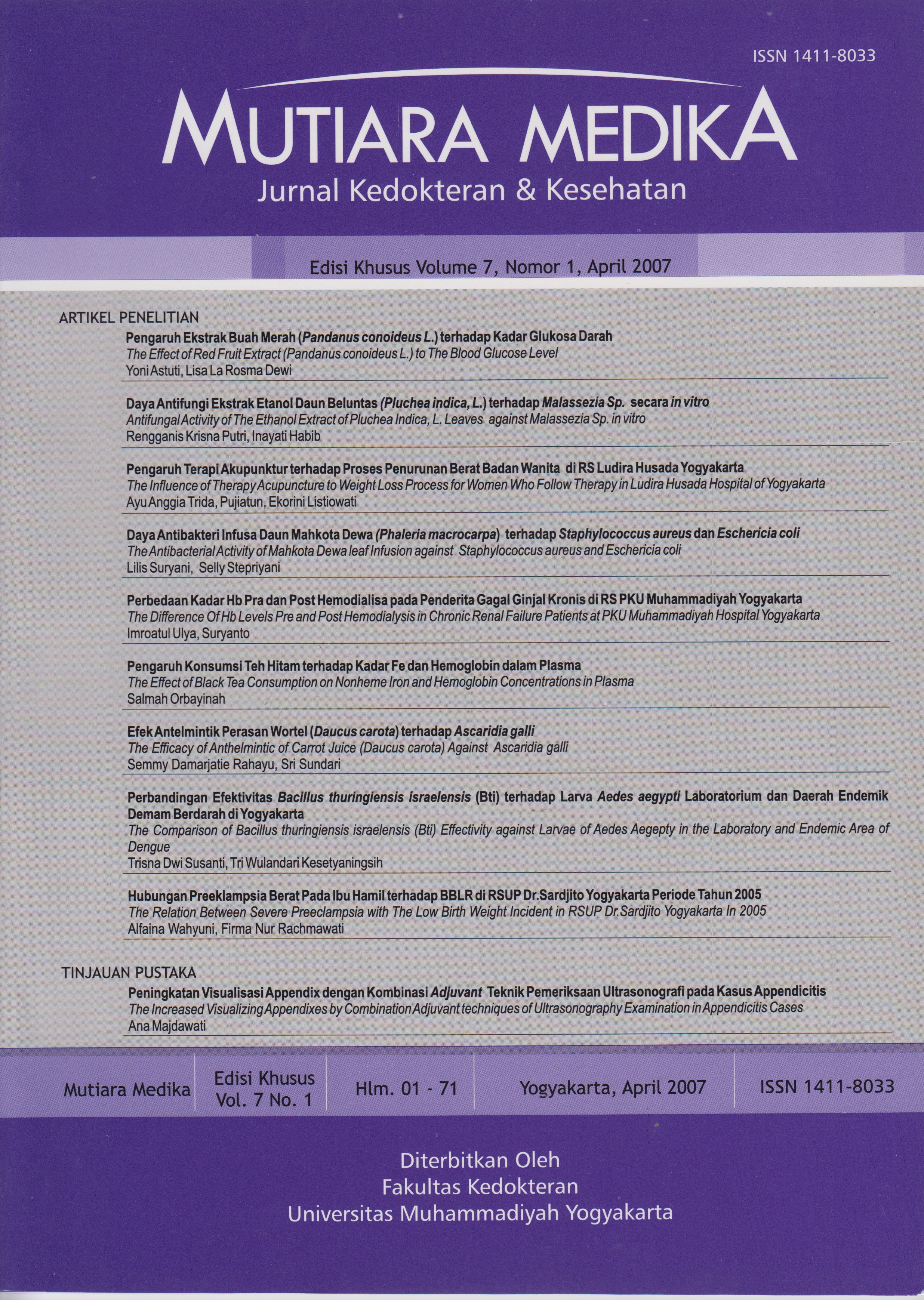Pengaruh Konsumsi Teh Hitam terhadap Kadar Fe dan Hemoglobin dalam Plasma
DOI:
https://doi.org/10.18196/mmjkk.v7i1%20(s).1682Keywords:
teh hitam, fe nonheme, hemoglobin, black tea, non-heme ironAbstract
Tea is one of the most popular drinks in the world. According to its production process, traditionally, tea divided into 3 kinds: green tea, oolong tea and black tea. Either green tea or black tea contains katekin. Both have potential to reduce non-hem iron absorption. The aim of this study is to reveal the effect of black tea consumption on non-heme iron absorption and hemoglobin concentration in plasma. This study is an experimental laboratory study. The subjects are 10 male mice (Mus muculus), ± 2 month years old, and weight of ± 25 grams which divided randomly into 2 groups. Each group consist of 5 mice, first group role as a control group which receive an aquades consumption and second group role as a black tea group which receive black tea water with 0,04gr/10ml dose for 14 days, one hour before meal. Non-heme iron and hemoglobin measurement was done before the study start and on 15th day of the study which use blood sample collect from lateral part of mice ’s eyes. The data collected then were analyzed with t- test paired samples method using SPSS program version 10 W. Results showed that non-heme iron concentration in black tea group (96,6800 ± 0,8273) higher significantly (p<0,05) and in control group (87,6760 ± 1,5340) less significantly (p<0,05). Hemoglobin concentration in black tea group (11, 2180 ± 0, 3355) and control group (10, 0100 ± 0, 2709) higher significantly (p<0,05). This results indicates that black tea consumption with 0,04gr/10ml dose for 14 days, one hour before meal not enough to reduce non-heme iron absorption and not decreasing the hemoglobin concentration of mice ’s plasma.
Teh merupakan salah satu minuman yang sangat populer di dunia. Berdasarkan proses pengolahannya, secara tradisional produk teh dibagi menjadi 3 jenis, yaitu teh hijau, teh oolong, dan teh hitam. Baik teh hijau maupun teh hitam mengandung katekin. Keduanya berpotensi untuk menghambat penyerapan besi nonheme. Tujuan dari penelitian ini adalah untuk mengetahui pengaruh konsumsi teh hitam terhadap absorpsi besi nonheme dan kadar hemoglobin dalam plasma . Penelitian ini adalah penelitian eksperimental laboratorium. Subyek penelitian adalah 10 ekor mencit (Mus musculus) jantan, umur ± 2 bulan, berat badan ± 25 gram dibagi menjadi 2 kelompok secara acak. Tiap kelompok berjumlah 5 ekor mencit, kelompok kontrol yang diberi konsumsi akuades sedangkan kelompok perlakuan diberi konsumsi seduhan teh hitam dengan dosis 0,04gr/10ml selama 14 hari satu jam sebelum makan. Pengukuran fe non-heme dan hemoglobin dilakukan sebelum perlakuan dan pada hari ke-15 dengan menggunakan sampel darah yang diambil dari bagian lateral mata mencit. Data yang diperoleh dianalisis dengan metode t-test paired samples. Hasil penelitian menunjukkan, terjadi peningkatan kadar Fe nonheme pada kelompok teh hitam (96,6800 ± ± 0,8273) yang signifikan (p< 0,05) dan penurunan kadar Fe nonheme pada kelompok kontrol (87,6760 ± 1,5340) yang signifikan (p<0,05). Terjadi peningkatan kadar hemoglobin pada kelompok teh hitam (11,2180 ± 0,3355) dan kelompok kontrol (10,0100 ± 0,2709) yang signifikan (p<0,05). Dapat disimpulkan bahwa konsumsi teh hitam dengan dosis 0,04gr/10ml selama 14 hari satujam sebelum makan tidak cukup menghambat penyerapan Fe non heme dan tidak menurunkan kadar hemoglobin plasma mencit.
References
Hartoyo, A. (2003). Teh dan Khasiatnya bagi Kesehatan: Sebuah Tinjauan Ilmiah. Yogyakarta: Penerbit Kanisius.
Fulder, S. (2004). Khasiat Teh Hijau. Jakarta: Prestasi Pustaka Publisher.
Almatsier, S. (2001). Prinsip Dasar Ilmu Gizi. Jakarta: Penerbit PT Gramedia Pustaka Utama.
Guyton, A. C. (1997). Buku ajar fisiologi kedokteran. Jakarta: EGC.
Wirakusumah, E.S. (1999). Perencanaan menu anemia gizi besi. Jakarta: Trubus Agriwidya.
Unit Penelitian Hewan Percobaan (UPHP) Universitas Gadjah Mada. (2005) Kandungan Pelet. Yogyakarta.
Astawan, M. (2003). Tempe. Wikipedia Indonesia, ensiklopedia bebas berbahasa Indonesia, http:// id.wikipedia.org
Samman, S., et al., (2001). Green tea or rosemary extract added to foods reduces nonheme-iron absorption. American Journal of Clinical Nutrition, Vol. 73, No. 3, 607-612.
Downloads
Published
Issue
Section
License
Copyright
Authors retain copyright and grant Mutiara Medika: Jurnal Kedokteran dan Kesehatan (MMJKK) the right of first publication with the work simultaneously licensed under an Attribution 4.0 International (CC BY 4.0) that allows others to remix, adapt and build upon the work with an acknowledgment of the work's authorship and of the initial publication in Mutiara Medika: Jurnal Kedokteran dan Kesehatan (MMJKK).
Authors are permitted to copy and redistribute the journal's published version of the work (e.g., post it to an institutional repository or publish it in a book), with an acknowledgment of its initial publication in Mutiara Medika: Jurnal Kedokteran dan Kesehatan (MMJKK).
License
Articles published in the Mutiara Medika: Jurnal Kedokteran dan Kesehatan (MMJKK) are licensed under an Attribution 4.0 International (CC BY 4.0) license. You are free to:
- Share — copy and redistribute the material in any medium or format.
- Adapt — remix, transform, and build upon the material for any purpose, even commercially.
This license is acceptable for Free Cultural Works. The licensor cannot revoke these freedoms as long as you follow the license terms. Under the following terms:
Attribution — You must give appropriate credit, provide a link to the license, and indicate if changes were made. You may do so in any reasonable manner, but not in any way that suggests the licensor endorses you or your use.
- No additional restrictions — You may not apply legal terms or technological measures that legally restrict others from doing anything the license permits.






